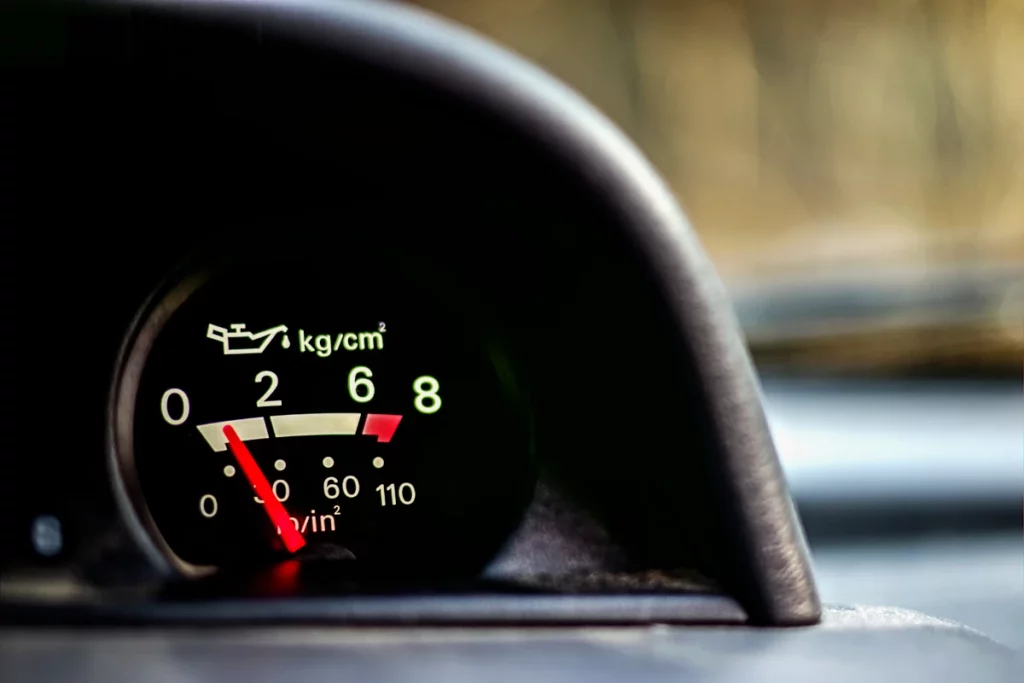A lot of people tend to forget that the oil pressure gauge is actually pretty important on a car because your engine needs enough oil to make sure that it is working properly especially considering that the different moving parts in the engine need to be lubricated well enough.
Then again, the reason why some people don’t really mind the oil pressure gauge is that they probably don’t know how to read it.
How do you properly read an oil pressure gauge?
After a tune-up, read the gauge as you are driving so that you will be able to establish a normal baseline. From there, look at the gauge if it drops or increases significantly when you are turning or accelerating so that you can adjust the amount of oil or the oil pressure relief valve.

The oil pressure gauge is actually pretty simple to read and use because you only have to look at the values where the gauge is pointing out to know whether or not the oil pressure is too low or too high.
Of course, you also need to understand what constitutes low and high oil pressure and what is considered normal for your car.
If you don’t have an oil pressure gauge installed and would like to, read this excellent article: How To Install A Mechanical Oil Pressure Gauge? (With Video)
Related:
- 6 Reasons You Get Low Oil Pressure At Idle? (With Solutions)
- What Causes Oil Pressure Gauge Drops To Zero When Braking? (Explained)
- Why Does My Oil Pressure Gauge Go Up When I Accelerate? (Solved)
What is a normal oil pressure gauge reading?
There aren’t a lot of people who actually understand how important the oil pressure gauge is especially when it comes to the overall health of the car’s engine, which is the vehicle’s heart and soul.
In that regard, there are some people who don’t understand what the oil pressure gauge is telling you and whether or not the reading on the oil pressure gauge is still normal.
As such, before we start talking more about how to use the oil pressure gauge, it is important to learn what is considered to be “normal” when it comes to the reading on your oil pressure gauge so that it will be easier to understand how it works.
The oil pressure gauge is similar to any other gauge on your instrument cluster or dashboard in that there are numbers outlined around a circle and there is an arrow that moves around to tell you the reading of the oil pressure gauge. Wherever the arrow is pointing, that is the oil pressure.
In that regard, what is considered normal in terms of your car’s oil pressure should be where the arrow is pointing on a regular basis depending on what the car is doing.
If the car is idle or is stuck in traffic while the engine is turned on, the arrow should be pointing out somewhere between 20 to 30 PSI on the gauge.
Read this excellent article on the causes of low oil pressure at idle: What Causes Low Oil Pressure At Idle?
Meanwhile, if the car is accelerating, the gauge should be reading somewhere between 30 and 65 depending on how fast the car is moving and on the RPMs on the tachometer.
Read this excellent article on why the oil pressure gauge goes up when I accelerate: Why Does My Oil Pressure Gauge Go Up When I Accelerate?
How to read an oil pressure gauge?
Now that you understand what the normal level is on the oil pressure gauge, let’s now look at the proper way to read the oil pressure gauge.
This should be quite standard and normal but the only thing you need to understand here is knowing what’s normal and what’s not normal.
To start, what you need to do is to establish a baseline so that you will know what’s normal for your car’s oil pressure.
This depends on one car to another but the usual level should be somewhere between 20 and 65 PSI.
In establishing a baseline, it is best that you do so after tuning your car up because that is when its performance should be at its best.
Drive a few miles at your regular driving speed and try to look at the oil pressure gauge to understand where the normal level should be for your car. Again, this will depend on one vehicle to another.
So, from there, what you should try to do next is to decelerate or turn. Look at the oil pressure gauge to see if the drop is so sudden or if the reading has dropped to somewhere that shouldn’t be normal.
If the reading is below 20 and is closer to 5, that means that the oil pressure is getting critically low.
This could mean that you may need to add more oil.
You can also try accelerating your car at a steady rate so that the RPMs on the tachometer will increase.
The oil pressure should be directly related to the RPMs of your engine because your oil pump would have to work harder when the engine needs to work harder while you are accelerating.
Read this excellent related article: Why Does My Oil Pressure Gauge Go Up When I Accelerate?
So, if the oil pressure rises so suddenly, then that could mean that there might be problems with your tune-up. You may have to bring your car back to the mechanic to have it checked or maintained but this shouldn’t be too much of a problem as long as you remedy it quickly.
In most cases, you should be concerned when the oil pressure reading is above 80 PSI on your oil pressure gauge.
What does the oil pressure gauge tell you?
Now that you understand how to properly use the oil pressure gauge and how to read what’s on the gauge, we have to look at what the oil pressure gauge is actually trying to tell you so that you will know how important the oil pressure is.
So, basically, the oil pressure gauge is telling you that your car’s oil pressure is normal, too low, or too high.
If it is somewhere between 20 and 65, it is normal. However, if it is below 20 or if it is somewhere close to 80 or even beyond it, then that could mean that your oil pressure is either too low or too high. There shouldn’t be a problem if the oil pressure is normal but the problem arises when it is either too low or too high.
When the oil pressure is too low, that means that the engine isn’t getting enough oil because the oil pump isn’t working hard enough to get the oil into the engine.
Your engine needs enough oil because the different parts and components of an engine undergo a lot of movements that require constant lubrication or else they will get damaged. So, if the oil pressure is dangerously low, your engine isn’t getting enough oil due to several reasons.
Meanwhile, if the oil pressure gauge reading is too high, that means that the oil pump has to work harder to make sure that the engine is getting enough oil.
It should be normal for the oil gauge to increase when the engine is working harder during acceleration but it shouldn’t be normal for the reading to be too high when you aren’t even accelerating at a really high rate.
As such, this could mean that the oil pump has to work harder to pump oil into the engine because there might be a clog that is preventing the engine from getting enough oil.
There are several reasons why your oil gauge reading might be either too low or too high but the fact of the matter here is that it is dangerous to the engine if you allow the oil pressure to either fall below or rise above the normal levels because this can eventually damage the engine.
Sources
It Still Runs: Read oil pressure gauges
How a car works: How oil pressure gauge works
Firestone complete auto care: How does oil pressure gauge work



